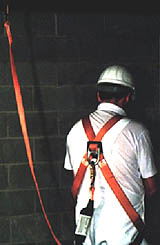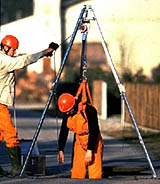Shipyard Employment eTool
PPE Selection >> Personal Fall Protection Equipment

When workers are exposed to fall hazards while working at elevations of more than five feet, or over water, fall protection is required. Typically, guardrails or other barriers are used to protect workers. In situations where guardrails are not practical, or when working from two-point suspended scaffolding, personal fall arrest systems (PFAS) (such as safety harnesses, lifelines, lanyards) are required. In some situations, positioning device systems such as restraint (tether) lines or aerial lifts are used to provide protection from falling off an unguarded edge. Personal fall protection systems must:
- Prevent a worker from falling (positioning device systems), or
- Arrest the fall of workers without causing injuries.
- Prevent workers from striking or falling to a lower level (PFAS).
Worker trauma from falls from elevated work surfaces can be minimized by the proper selection and use of personal fall protection systems.
The OSHA Hierarchy of Controls
- Engineering Controls
- Administration Controls
- Personal Protective Equipment (PPE)

Potential Hazards
- Falls caused by failure to use fall protection.
- Injuries due to improper use of fall protection equipment.
Requirements and Example Solutions
- When guardrails and other positive fall protection are not available to protect from falls, workers must use personal fall protection systems (such as harnesses, lanyards, lifelines). [29 CFR 1910.67, 29 CFR 1915.71, 29 CFR 1915.73, and 29 CFR 1915.77]

Training
- Before use, workers must be trained to understand [29 CFR 1915.159(d), 29 CFR 1915.160(d)]:
- The application limits (for example maximum permitted free falls, distance needed below to stop before hitting lower levels or objects, minimizing swing falls, etc.) of the equipment.
- Proper hook-up, anchoring, and tie-off techniques.
- Proper use, inspection, and storage of equipment.
- Personal fall protection systems must not be used for other purposes such as hoisting materials. [29 CFR 1915.159(c)(9)]
Inspection
- Personal fall protection systems must be inspected before each use and defective components must be removed from service. [29 CFR 1915.159(c)(5), 29 CFR 1915.160(c)(1)]
- Personal fall protection systems subjected to impact loading must be removed from service. [29 CFR 1915.159(c)(6), 29 CFR 1915.160(c)(2)]

Anchorage
- Workers must attach to an anchorage of sufficient strength (5,000 pounds). [29 CFR 1915.159(a)(9)]
- Workers must use anchorage points independent of the scaffold supporting system. [29 CFR 1915.159(a)(8)]
- Positioning device systems must be secured to an anchorage capable of supporting at least twice the potential impact load of a worker's fall. [29 CFR 1915.160(a)(3)]
Lifelines and Lanyards
- Each worker must be provided with their own separate vertical lifeline. [29 CFR 1915.159(b)(1)]
- Horizontal lifelines must be designed, installed, and used under the supervision of a qualified person. [29 CFR 1915.159(b)(5)]
- Workers must use systems that are rigged to prevent free fall of more than six feet or contact with the lower level. [29 CFR 1915.159(b)(7)]
- Lifelines and lanyards must be protected against damage such as cuts, abrasions, burns (hot work), acids, and solvents. [29 CFR 1915.159(c)(4)]

Snap Hooks and D-Rings
- Workers must use locking snaphooks. [29 CFR 1915.159, 29 CFR 1915.160(a)(4)].
- Snaphooks, unless designed for such connections, must not be connected to: [29 CFR 1915.159(a)(6)]
- Webbing, rope or wire rope
- Other snaphooks
- D-rings to which other snaphooks or connectors are attached
- Horizontal lifelines
- Other objects such as eye bolts that are incompatible
Rescue
- In the event of a fall, prompt rescue of workers must be provided. [29 CFR 1915.159(c)(7)]
Potential Hazards
- Falls due to anchorage or equipment failure.
- Injuries (for example damage to internal organs, fractures, abrasions) due to the use of improper fall protection equipment.
Requirements and Example Solutions
- Personal fall protection systems must meet the design, strength, and testing requirements for the equipment. [29 CFR 1915.159, 29 CFR 1915.160, and Subpart I Appendix B]
- Design requirements include:
- Maximum permitted arrest forces
- Minimum system strength
- Maximum permitted stopping distances
- Component strength
- Proof testing
- Corrosion-resistant materials
- Compatibility requirements
Additional Resources
- 29 CFR 1910.66 Appendix C, Section III – Additional Non-mandatory.
- Safety Belts, Harnesses, and Lanyards. Canadian Centre for Occupational Health and Safety (CCOHS). Provides FAQs about proper care and use of fall protection equipment.

